Japandi Interior Design: 10 Must-Know Styling Tips for Homes in Singapore
- What is Japandi & Why is It Gaining Popularity in Singapore?
- Japandi Interior Tips for Tropical Homes: Heat & Humidity Solutions
- Japandi Interior & Housing in Singapore: Finding the Right Balance
- Japandi-Inspired Furniture & Decor Ideas for Singapore Homes
- Creating a Japandi-Inspired Dining or Living Room in Singapore
- Achieving Japandi Balance and Simplicity in Singapore Homes
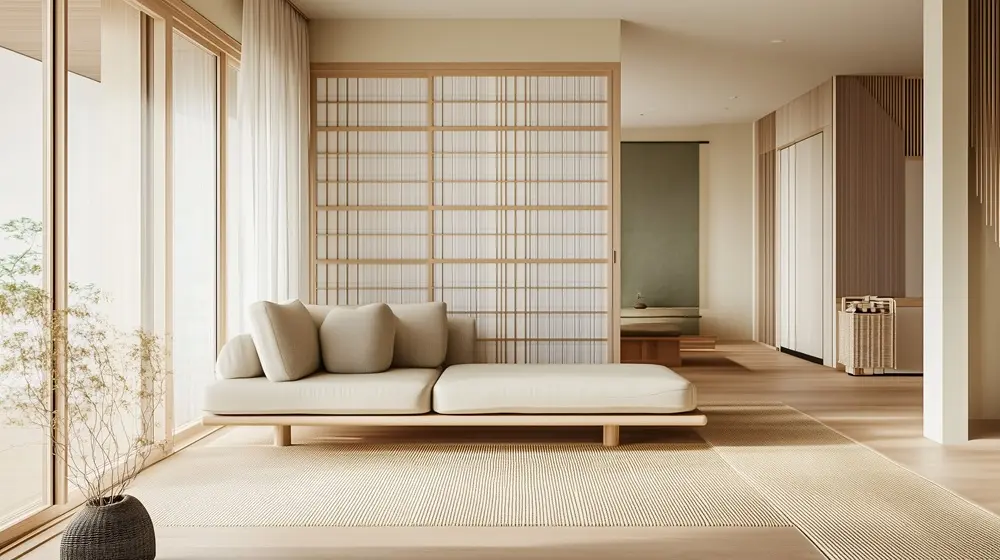
Love Japandi design but worried about humidity, space constraints, or practicality in sunny island, Singapore? While Japandi's natural wood finishes, neutral tones, and decluttered aesthetic are timeless, adapting them to the region's hot and humid climate requires careful planning.
Also, with smaller living spaces in many urban homes, balancing Japandi's minimalist philosophy with everyday functionality can be a challenge. Nevertheless, having the right approach can help you achieve a beautiful, airy, and practical Japandi-inspired home without sacrificing comfort.
In this guide, we will share 10 essential Japandi interior design tips, from selecting moisture-resistant materials to maximizing airflow and natural light. Whether you are designing a cozy HDB, a sleek condo, or a spacious landed house, these insights will help you create a serene, clutter-free space that complements your local climate and lifestyle.
What is Japandi & Why is It Gaining Popularity in Singapore?
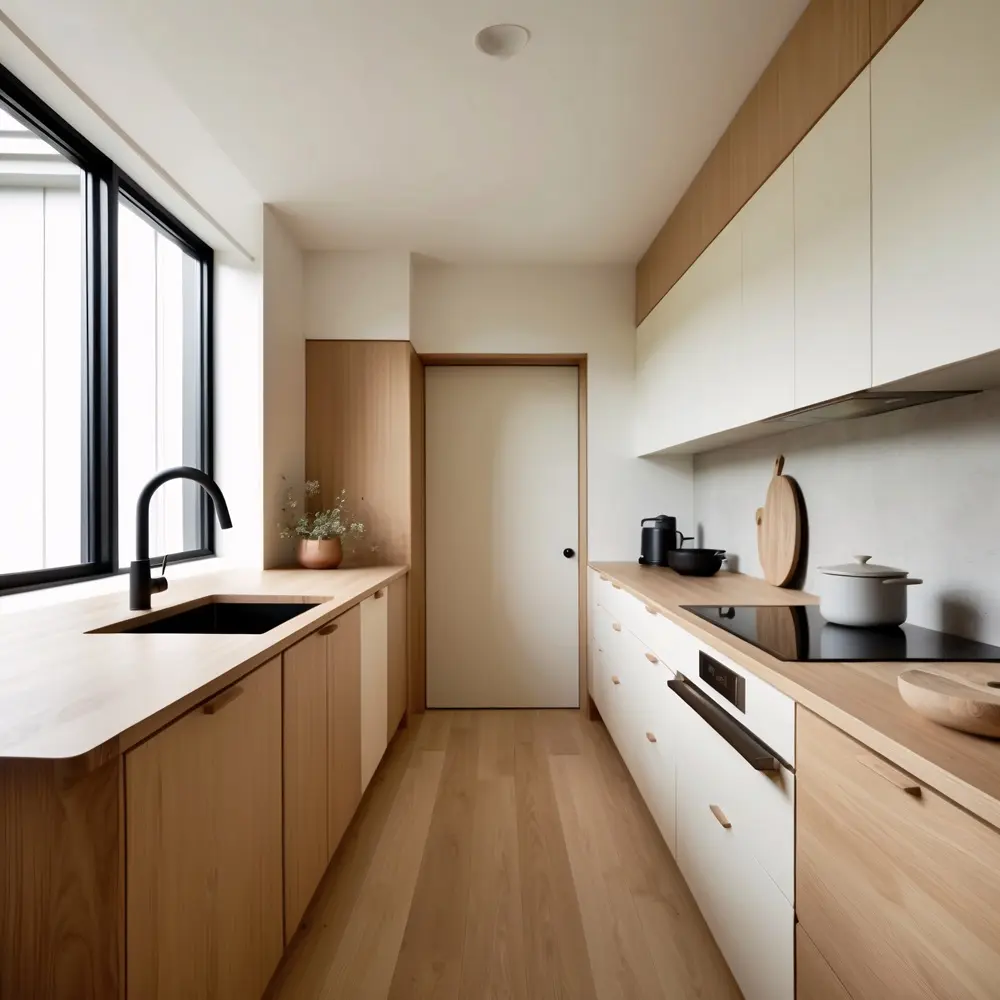
Japandi is a design trend that combines the best of Japanese minimalism and Scandinavian functionality, creating spaces that are calm, cozy, and beautifully simple. Rooted in Japanese wabi-sabi, which celebrates imperfection and natural materials, and Scandinavian hygge, which focuses on warmth and comfort, Japandi emphasizes neutral tones, clean lines, and materials like wood, stone, and linen. Although wood is not naturally resistant to moisture, we will guide you on the best materials and finishes to ensure durability in humid climates like Singapore's.
Japandi's focus on natural materials and eco-conscious principles aligns with the growing demand for sustainable living in Singapore. Its functional, space-saving furniture is ideal for compact urban spaces like HDB flats and condos. The style's blend of Eastern tranquility and Western coziness resonates with Singapore's cultural fusion, appealing to homeowners who seek both warmth and balance.
Japandi Interior Tips for Tropical Homes: Heat & Humidity Solutions
1. Material Selection for Humidity
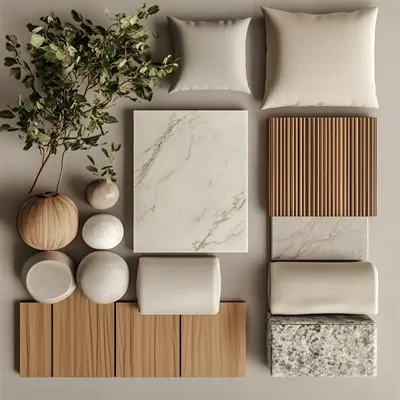
The tropical heat and humidity in Singapore can pose significant challenges for interior design, especially when it comes to choosing suitable materials that can handle the moisture while maintaining the serene, earthy vibe of the style.
Use solid wood alternatives like engineered wood or teak that resist warping. Teak is naturally resistant to moisture and decay, making it a popular choice in both Japandi and tropical homes. Engineered wood provides a sturdy and reliable alternative that can hold up well over time, even in moisture-rich environments.
Opt for rattan and bamboo furniture for a natural touch and breathability. Rattan and bamboo furniture pieces, such as chairs, side tables, or even woven wall panels, provide the perfect balance of style and practicality while promoting airflow.
Prioritise both aesthetic appeal and practicality for flooring to withstand heat and humidity. Engineered wood and bamboo are excellent choices for their durability and moisture resistance, offering natural warmth that complements Japandi's minimalist style. Microcement and matte porcelain or ceramic tiles are ideal for high-humidity areas like the kitchen and toilet, providing sleek, moisture-resistant surfaces that align with Japandi's clean, understated look. Wood-look vinyl or laminate adds a sustainable, comfortable texture, a budget-friendly alternative with Japandi warmth.
2. Light and Airy Spaces
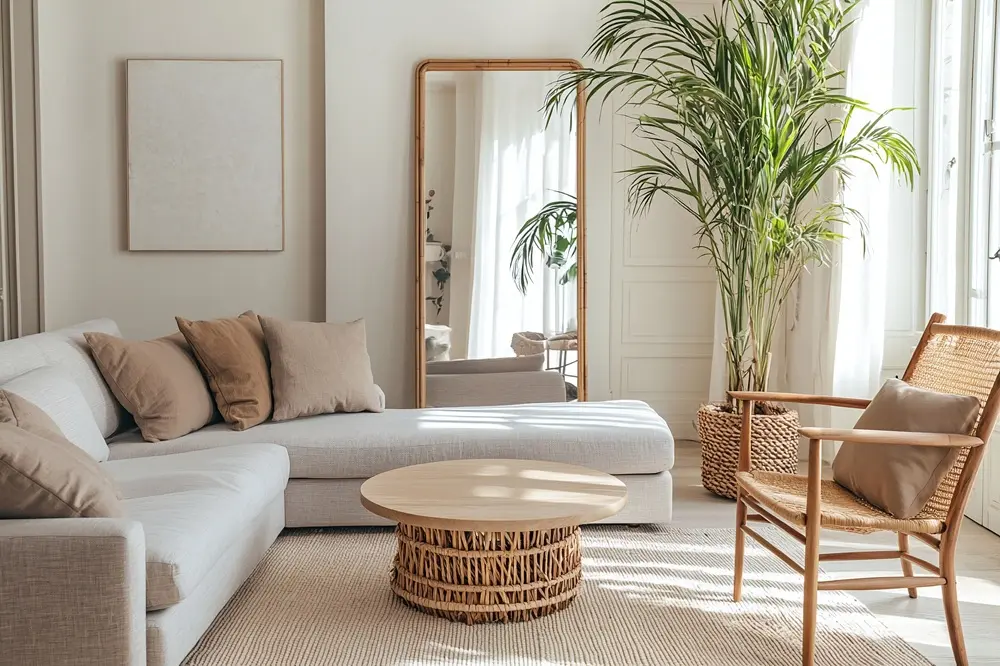
Creating a light and airy atmosphere is crucial in Japandi design, especially in tropical climates where keeping spaces cool and ventilated is key to comfort. The goal is to optimize natural light while ensuring a breezy, uncluttered environment.
Japandi interiors often rely on a neutral color palette, which not only creates a peaceful, serene environment but also helps reflect natural light. In humid environments, light tones like beige, warm white, or muted greys work particularly well. These shades create a sense of openness and airiness, making spaces feel larger and brighter. Light colors also help maintain a cooler ambiance, which is important for homes where heat can build up quickly. In contrast, bold, saturated colors like fiery red or deep orange can make a space feel visually heavy and overwhelming. Instead of reflecting light softly, they can create a stifling effect, especially in warm climates where heat and humidity already contribute to a sense of discomfort.
Use sheer linen or cotton curtains to maintain privacy while allowing natural light to filter through. These lightweight fabrics promote airflow, aiding in humidity control and reducing the need for air conditioning, which is especially beneficial in Singapore. Soft, neutral-toned curtains complement Japandi’s minimalist aesthetic, adding a calming, organic texture to the space.
In hot, humid climates, ceiling fans are essential for comfort and energy efficiency. Fans with wooden blades complement Japandi design, seamlessly blending with natural materials while enhancing airflow. As an eco-friendly alternative to air conditioning, they improve air circulation and reduce energy consumption, making them both practical and stylish.
Japandi Interior & Housing in Singapore: Finding the Right Balance
1. Maximizing Japandi Style in Compact Spaces
Living in HDB flats, studio apartments and high-rise condos in Singapore often means dealing with compact spaces, limited natural light, and structural constraints such as fixed walls and small room layouts. Japandi design offers practical solutions to overcome these challenges while maintaining its signature minimalist elegance.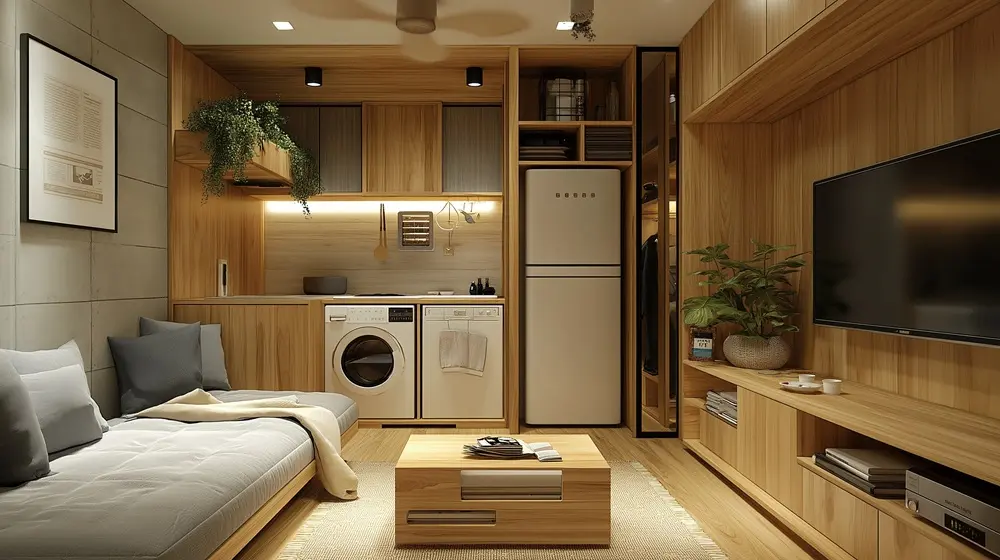
Storage Solutions
One of the biggest challenges in compact spaces is storage. Custom-built storage solutions with light wood finishes (such as platform beds with drawers or wall-mounted shelving) keep the space organized without overcrowding. Open shelving in light wood tones helps maintain a minimalist, airy feel while providing practical storage.
Sliding Doors
To maximize space and improve flow between rooms, consider Shoji-style sliding doors or fluted glass partitions. These designs open up rooms without taking up space for door swings. They also maintain privacy while allowing light to filter through, enhancing the open feel of smaller homes.
Light-Colored Flooring
Choose vinyl planks or large-format tiles in warm oak, sand, or light grey tones to create an airy, expansive feel. Lighter flooring reflects more light, which helps to brighten the space and makes the rooms feel larger and more open, especially when natural light is limited.

Multi-purpose Furniture
Furniture that serves multiple purposes is key to Japandi design in small homes. For example, foldable dining tables or nesting coffee tables can be tucked away when not in use, and Murphy beds offer the flexibility of a guest room that does not dominate the space when not needed.
Minimalist Lighting
Instead of using multiple downlights, which can feel cluttered in smaller spaces, opt for a single statement pendant light or track lighting. This provides ample lighting without overcrowding the ceiling with fixtures, and the clean, sleek lines align with Japandi's aesthetic.
Japandi-Inspired Transformation of a 5-Room HDB Flat: Maximizing Space and Serenity
As an illustration, a 5-room HDB flat in Singapore was beautifully transformed using Japandi principles. The design featured a neutral palette with open-concept wooden cabinetry in the kitchen, making the space feel larger and more cohesive. A tatami-style corner was added for relaxation, using minimalist furniture to keep the space feeling cozy yet uncluttered. Custom storage units and sliding Shoji doors enhanced the overall flow, ensuring both functionality and beauty in the compact layout.
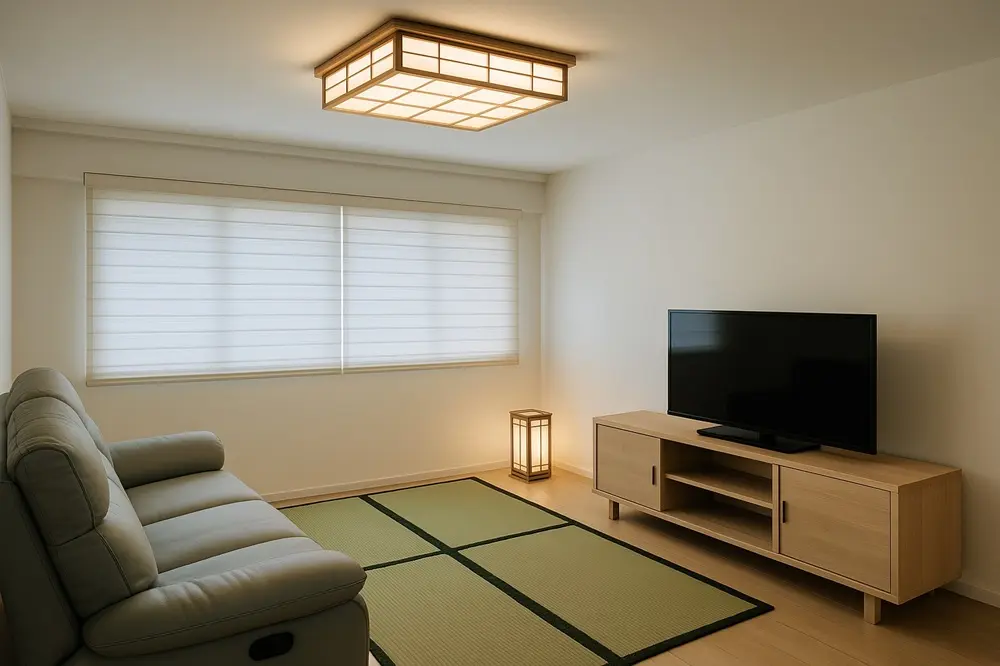
Photo courtesy of the homeowner, used with permission. Edited and refined using AI.
2. Landed Houses & Larger Condos
While landed houses and larger condos in Singapore offer more space, they can feel empty or disjointed without thoughtful design. The key challenge in these larger homes is ensuring that the design does not overwhelm the space, while still maintaining a cohesive and intimate atmosphere. Japandi design offers several solutions for transforming larger spaces into harmonious, balanced environments that feel warm, cozy, and functional.
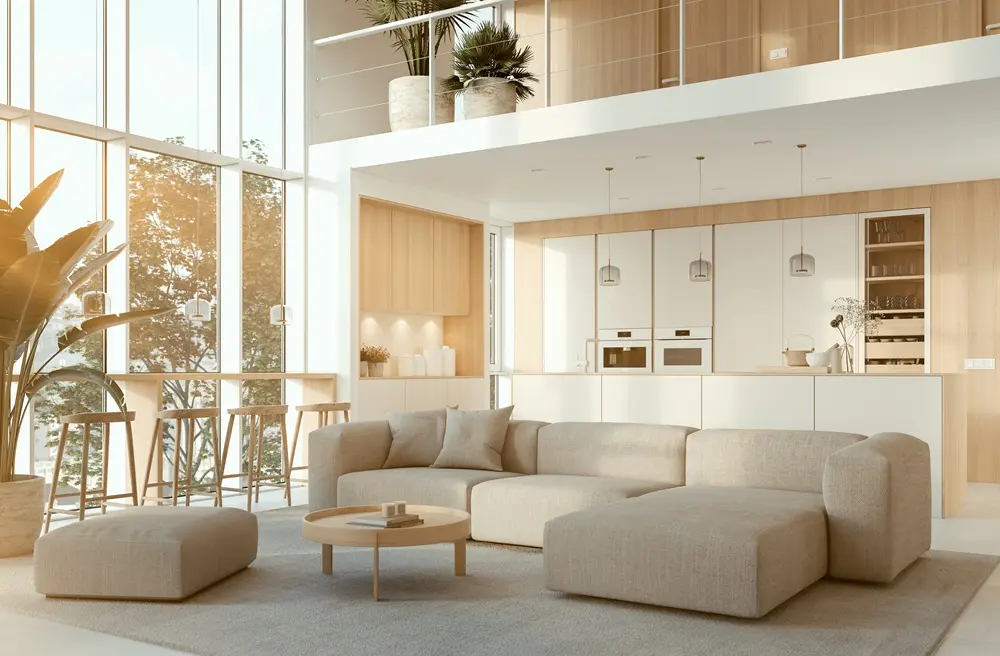
Natural Ventilation
Larger homes, especially in tropical climates, benefit from natural airflow. Incorporating features like wooden louvered panels or open-concept layouts helps promote cross-ventilation, ensuring that spaces stay cool and fresh without relying too heavily on air conditioning. Sliding doors or bi-fold windows also contribute to a breezy environment and seamless connection between indoor and outdoor spaces, which is a hallmark of Japandi’s connection with nature.
Concrete or Stone Textures
To add depth and subtle interest to larger walls, incorporate microcement or fluted concrete panels. These materials give a tactile, organic feel to the space without disrupting the clean, minimalist aesthetic of Japandi design. Stone textures on feature walls can also add sophistication and warmth, providing a visual anchor in expansive rooms.
Indoor Greenery and Outdoor Garden Spaces
Japandi design is deeply inspired by nature, making both indoor greenery and outdoor gardens essential for creating a harmonious home. Bring the outdoors in with a Zen garden or lush plants in key areas like balconies, entryways, or even under staircases. These green spaces promote tranquility and soften architectural lines.
For outdoor areas, a minimalist courtyard or garden with carefully placed plants, pebbles, and wooden elements brings out the Japandi aesthetic. Adding a small water feature or bonsai enhances the calming atmosphere, creating a seamless flow between indoor and outdoor serenity.
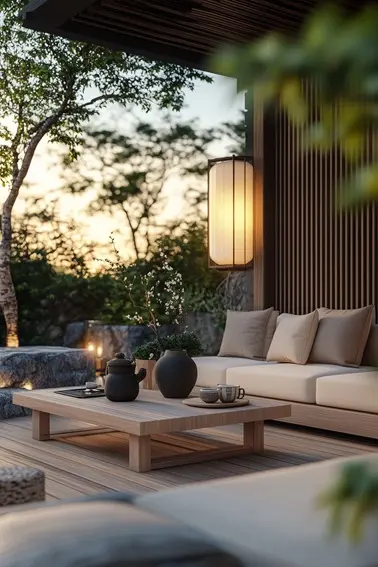
Statement Furniture
In larger homes, it is important to invest in statement pieces that add character and warmth without cluttering the space. A solid wood dining table paired with Scandinavian-inspired chairs can serve as a focal point in a large dining area. The minimalist design of the chairs prevents the room from feeling overcrowded, while the rich wood grain adds depth and texture.
Zoning with Furniture
In larger homes, creating distinct zones for different activities is essential. Use low-profile sofas and area rugs to define living, dining, and relaxation areas. By keeping the furniture modular and low to the ground, you avoid overwhelming the space while maintaining the open, airy feel central to Japandi. Rugs not only anchor the space but also add texture and warmth, bringing a sense of intimacy to expansive rooms.
Transforming a Semi-Detached House with Japandi Elegance and Natural Serenity
As an illustration, a semi-detached house in Singapore was thoughtfully renovated with Japandi principles. This spacious living and dining area embodies Japandi elegance, seamlessly blending minimalist Japanese aesthetics with Scandinavian warmth. Thoughtful zoning divides the space into a cozy lounge and an inviting dining area, both unified by natural wood tones, soft neutral fabrics, and abundant natural light. The large floor-to-ceiling windows create an airy openness, connecting the indoors to a tranquil Zen garden. This garden, visible from the living space, introduces a peaceful natural element, reinforcing the home's serene ambiance. With carefully chosen textures and an emphasis on organic materials, this semi-detached house becomes a sanctuary of calm and refined simplicity.
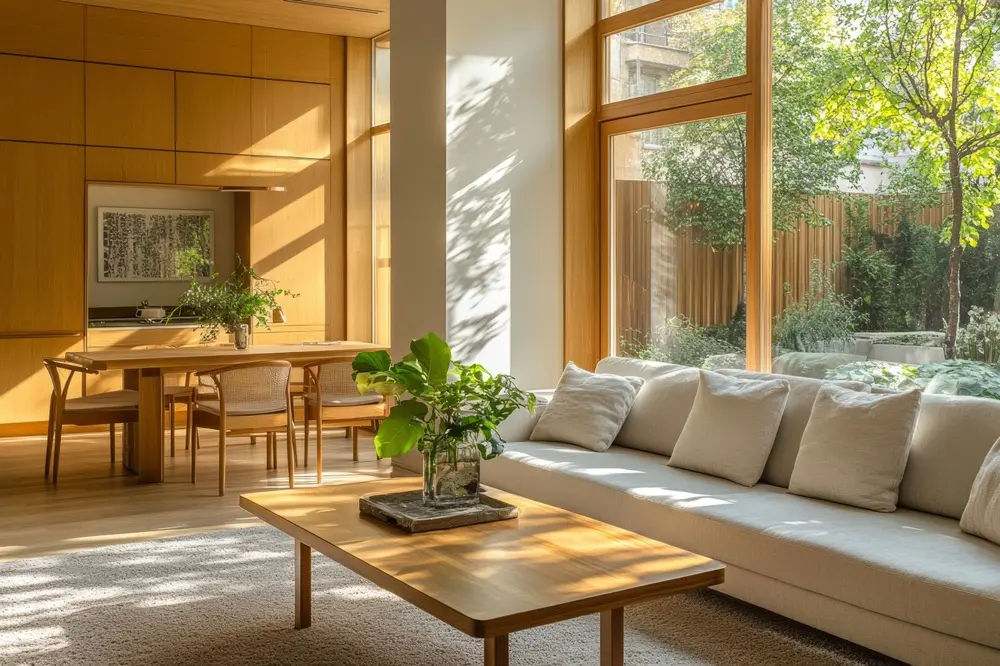
This image is a stock photo for reference purposes only and may not reflect the actual property.
Japandi-Inspired Furniture & Decor Ideas for Singapore Homes
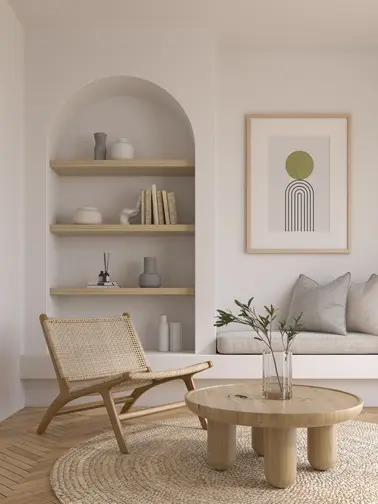
1. Opt for Rattan Chairs, Woven Baskets, and Bamboo Shelving
Lightweight yet durable, rattan chairs provide airy and comfortable seating, perfectly suited for warm weather. Woven baskets serve as both practical storage and decorative elements, adding texture and warmth while holding blankets, magazines, or plants. Meanwhile, open bamboo shelving offers a stylish yet functional way to showcase Japandi-inspired ceramics, books, or greenery, seamlessly blending simplicity with nature-inspired design.
2. Choose Japandi-Inspired Textiles for a Cozy Ambiance
While Singapore's climate is warm, the right textiles can enhance comfort without feeling heavy, making them essential in Japandi design. Emphasizing natural fabrics in soft, earthy tones, linen cushions offer breathability and a relaxed, lived-in look that complements a minimalist aesthetic. Lightweight wool or cotton-blend throws provide warmth on cooler days or in air-conditioned spaces without overwhelming the room. Meanwhile, neutral-toned rugs made from jute, seagrass, or wool blends add texture and coziness, grounding the space with a natural, understated elegance.
3. Select Decor and Artisan Pieces from Local Japandi-inspired Design Stores
Explore curated selections that emphasize simplicity, craftsmanship, and sustainability in local Japandi-inspired design stores. Scanteak specializes in Scandinavian-style teak furniture that complements Japandi interiors, while Soul & Tables focuses on sustainable wood pieces with a minimalist aesthetic. Ethnicraft Online features timeless wooden furniture with clean lines and natural finishes, and Noden offers a boutique selection of mid-century and Japandi-inspired pieces. For those seeking woven, rattan, and bamboo elements, Island Living provides furniture that blends seamlessly with the Japandi decor style, enhancing both functionality and warmth.
Additionally, sourcing pieces from Singaporean artisans or specialty stores adds a personal and localized touch to Japandi interiors while honoring the style's emphasis on craftsmanship and simplicity. Look for unglazed stoneware in earthy tones and raw textures to complement Japandi's natural aesthetic. Hand-thrown ceramic bowls and mugs serve as both functional and decorative elements, perfect for open shelving or daily use. Meanwhile, locally inspired vases with minimalist, organic shapes provide an elegant way to display dried flowers, branches, or single-stem arrangements.
4. Introduce Low-Maintenance Indoor Plants for Added Greenery
Given Singapore's humid climate, opting for low-maintenance plants ensures effortless upkeep while enhancing the home's organic appeal. Snake plants, with their sculptural form and air-purifying properties, thrive in low light, making them ideal for indoor settings. Pothos, a resilient trailing plant, adds a soft, flowing element when placed on shelves or in hanging planters. For a bold yet elegant touch, ficus or rubber plants feature broad, glossy leaves that require minimal care. To complement the Japandi aesthetic, house these plants in neutral-toned ceramic pots or woven baskets, allowing them to blend seamlessly with natural wood, rattan, and linen textures.
Creating a Japandi-Inspired Dining or Living Room in Singapore
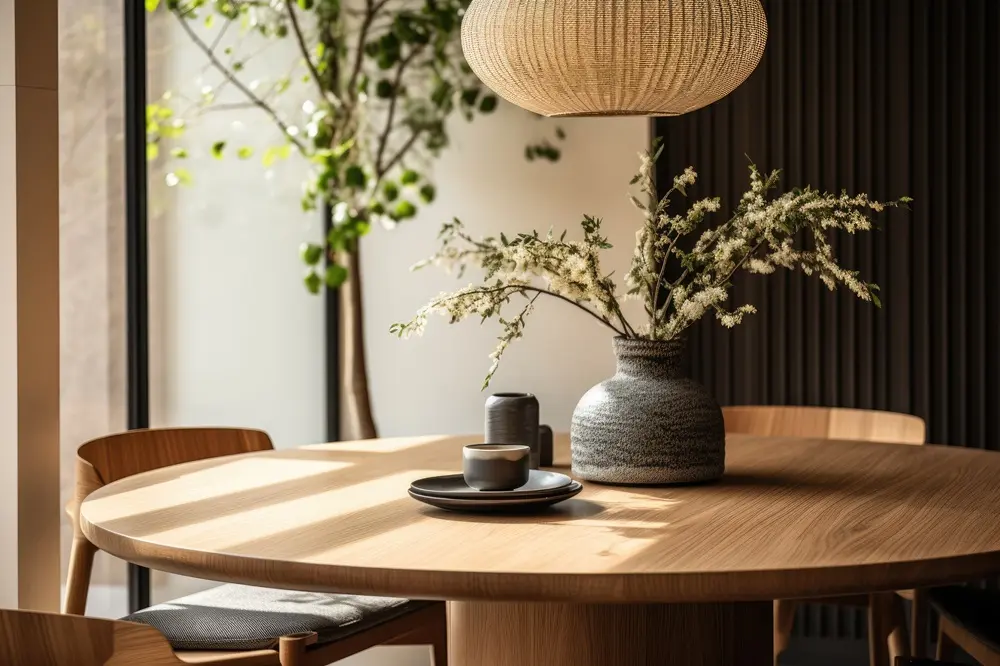
1. Choose Sturdy Wooden Dining Tables with Clean Lines
A solid wood dining table serves as the centerpiece of a Japandi-inspired dining space, offering durability and timeless elegance. Opt for tables crafted from oak, teak, or walnut, as these woods not only withstand humidity but also develop a beautiful patina over time. Keep the design simple with clean lines and a matte or natural finish to enhance the organic feel. Pair the table with cushioned rattan chairs, which provide both comfort and breathability, making them ideal for Singapore's warm climate.
2. Incorporate Pendant Lighting for Soft, Warm Illumination
Swap harsh overhead lights for pendant lamps with paper or woven shades, which diffuse light softly and add a handcrafted element to the space. Shoji-inspired paper lanterns or rattan pendant lights work beautifully to evoke a serene, nature-inspired ambiance while complementing the wooden elements in the room. Dimmable LED bulbs can further enhance the coziness of the space, allowing you to adjust the lighting for different moods.
Achieving Japandi Balance and Simplicity in Singapore Homes
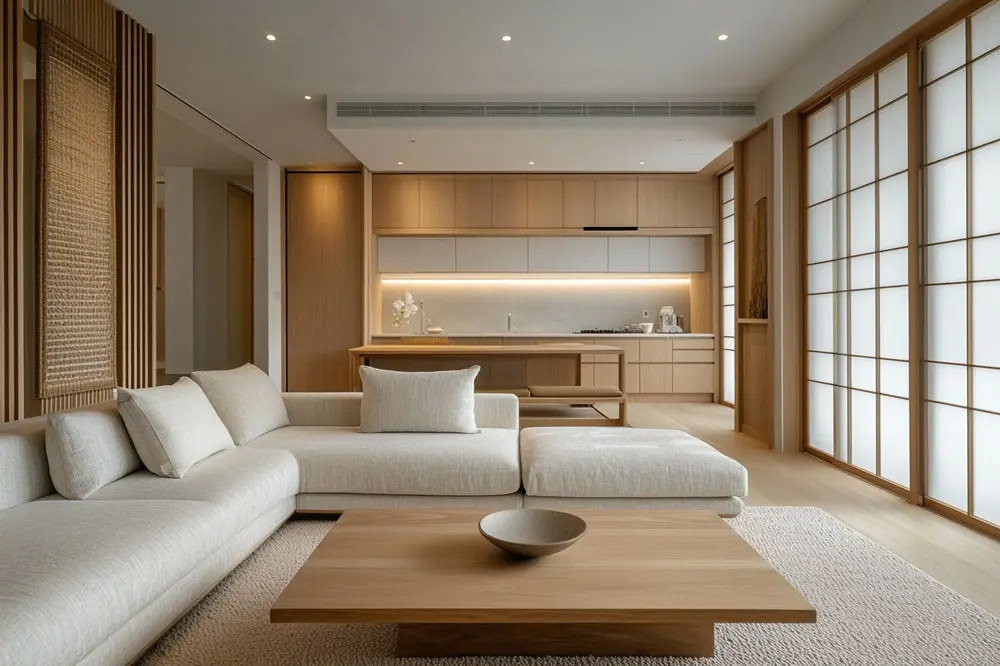
Japandi design seamlessly combines Japanese simplicity with Scandinavian functionality, making it an ideal choice for homes in Singapore. Despite challenges like humidity and space constraints, Japandi's focus on natural materials, clean lines, and minimalist principles ensures its adaptability. By selecting moisture-resistant materials, maximizing airflow, and integrating smart storage, homeowners can create serene, clutter-free spaces that suit the local climate and lifestyle.

